As an Amazon Associate, we earn from qualifying purchases with no additional costs for you.
Sharpening a knife is a learned skill, with right and wrong ways of performing the task. Many beginners are unsure if they should pull or push the knife while sharpening. We will clear up this aspect of knife sharpening to help you to improve your skill level.
Pulling the knife edge across a whetstone trailing the knife’s spine is the best way to sharpen a knife. This creates a smooth edge, free of rough gouges, and can be taken to a much greater level of sharpness as a result. Pushing the knife and leading with the edge is not recommended.
The confusion comes into knife sharpening for beginners, where they watch an experienced person sharpening a knife, and the person appears to be moving the knife with a push-and-pull motion. While this may look confusing, it is all about the pressure being applied.
If you are interested in checking out the best whetstones for your knives we recommend and use, you can find them by clicking here (Amazon link).
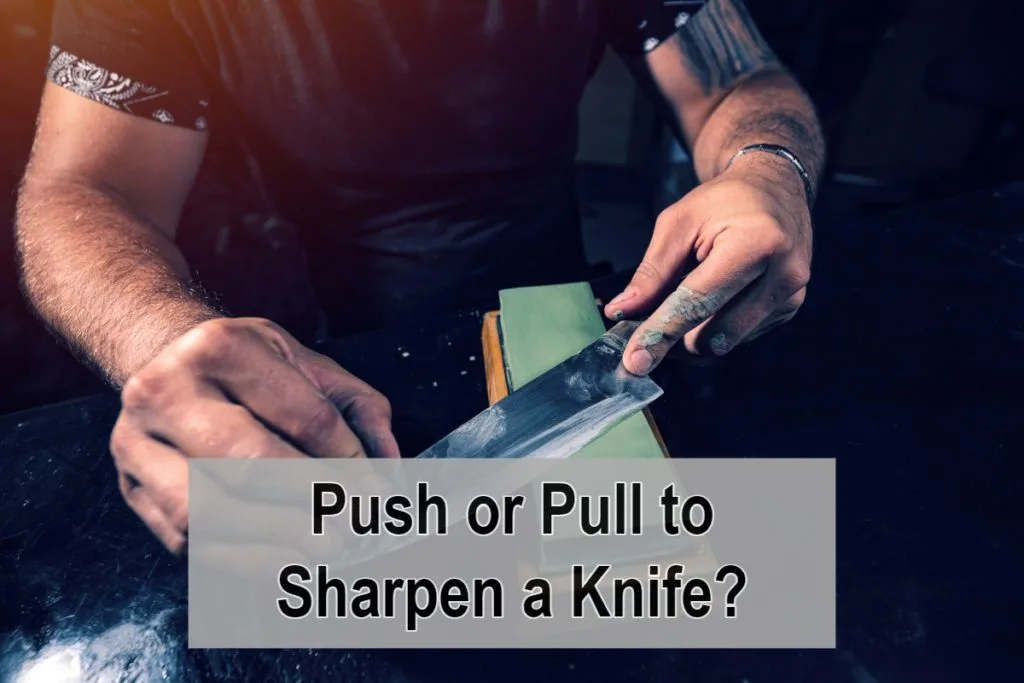
What Is The Right Way To Sharpen A Knife?
Whether pushing or pulling a knife through or over a sharpener is the correct technique is incorrect in some instances and optional in others.
The correctness of the technique will largely depend on the type of sharpener or sharpening method you are using to get an edge on your knife.
- Pull through sharpeners.
Manual pull-through sharpeners should use an action where you start at the knife’s heel and pull the knife toward you through the sharpener, towards the tip of the knife. This action gives you a smooth, more controlled action through the sharpener with even pressure over the length of the blade.
- Electric sharpeners.
With most electric sharpeners that use a static abrasive, the best method is to start at the knife’s heel and pull the knife back towards you. Some electric sharpeners instruct to use a push, and then a pull stroke, but a pull stroke is more controlled.
- Belt sharpeners.
Knife sharpeners that have an abrasive belt can be used with a push or a pull stroke through the sharpener. This is because the sharpening action will be determined by the direction of travel of the abrasive belt.
- Whetstone sharpeners.
This is probably the most controversial method, where some people use a push stroke, some a pull stroke, and others use a combination. We will discuss this method a little later in more detail and give our recommendation.
If you are using a commercially manufactured sharpener, it is always best to follow the manufacturer’s recommendation for the correct method for using the sharpener.
However, it is easier to maintain control and angles on a pull stroke than a push stroke.
TIP: Are you looking to buy a new whetstone? Check out our recommendations (we personally use the first three ones):
Our PRO choice whetstones combo (Amazon links):
- Fixing stone: Whetstone SHAPTON Ceramic KUROMAKU #320
- Sharpening stone: Suehiro CERAX soaking whetstone: Medium #1000
- Finishing stone: Whetstone SHAPTON Ceramic KUROMAKU #5000
Our budget choice (Amazon link): Sharp Pebble Extra Large Sharpening Stone Set
Is It Better To Push Or Pull When Sharpening A Knife?
The question about pushing or pulling a knife when sharpening, especially on a whetstone, requires the orientation of the edge to be considered.
The main consideration in the orientation of the knife edge in the sharpening action is whether the sharp edge is leading or trailing in the push or pull action.
Do You Push Or Pull A Knife On A Whetstone?
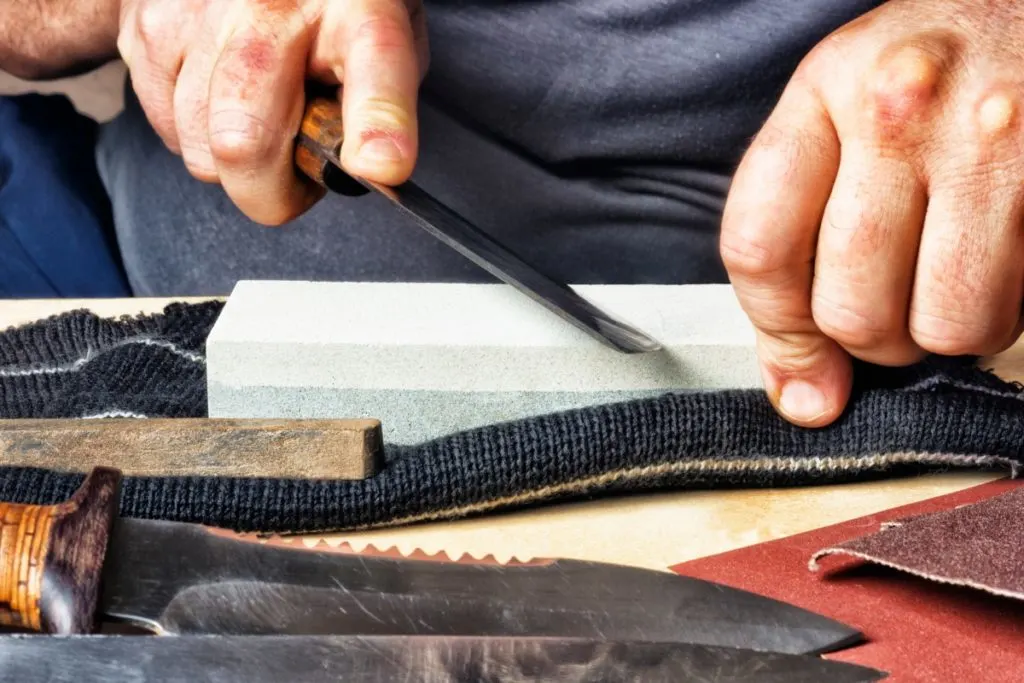
When you use a whetstone for sharpening, your action will change when you turn the knife over to work on the opposite bevel of the edge.
When you have the knife edge on the whetstone, and the sharp edge is facing away from you, the best option is to pull the knife towards you, making the edge trail the spine.
To do this, the stroke will start at the far end of the whetstone, and you will pull the knife towards you and you move the length of the blade across the stone.
Each stroke will start at the far end of the stone and finish at the edge of the whetstone closest to you, with the knife’s spine leading the edge. This action usually starts at the heel of the knife and finishes at the tip.
When you turn the knife over, you will reverse the action. Place the knife with the edge facing towards you on the edge of the stone closest to you.
You will then push the knife away from you towards the furthest part of the whetstone to your position.
When you sharpen this side of the knife with the push action, you would usually start at the tip at the beginning of the stroke and finish with the knife’s heel at the far end of the whetstone.
When you watch experienced people sharpening knives, it sometimes appears that they push and pull the knife across the stone in a back-and-forth motion.
However, in the pull stroke, pressure is applied to the knife on the stone, and in the return stroke, no pressure is applied to the blade.
Conversely, in the push stroke, pressure is applied in pushing the knife away, but no pressure in the return stroke.
TIP: If you want to know more about how to sharpen a knife on a whetstone properly, check out the ultimate guide in the article below:
Step-By-Step GUIDE: How To Sharpen A Knife With A Whetstone
Differences Between Pushing And Pulling When Sharpening A Knife
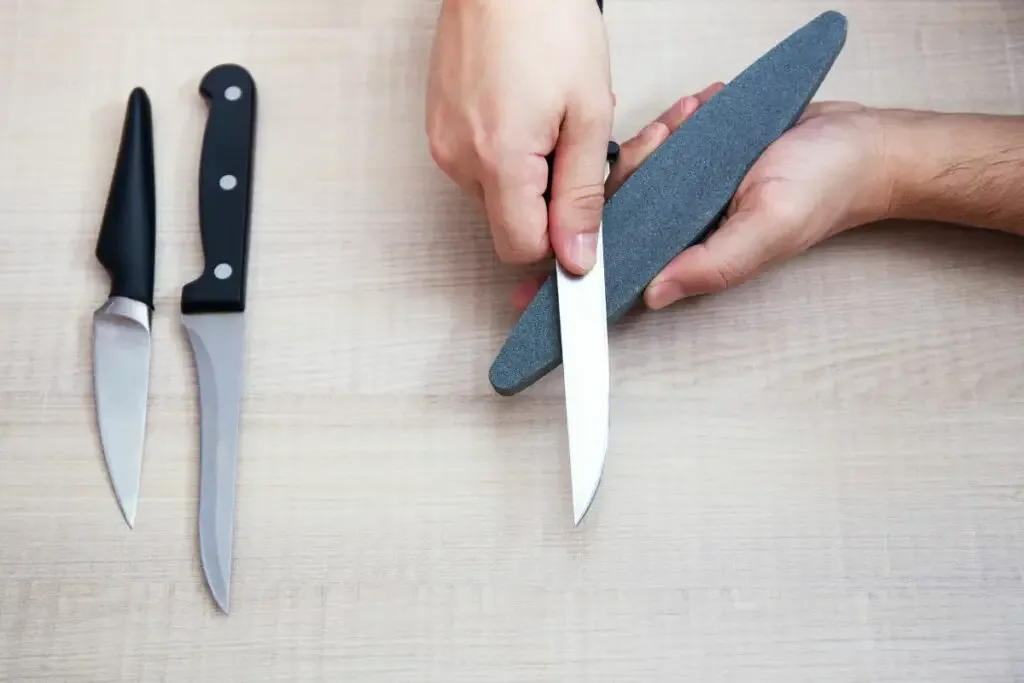
Some people who use whetstones prefer to sharpen the knife using the sharp edge as the leading edge when drawing the knife across the stone.
There is some controversy about whether drawing the knife with the edge leading across the stone is the correct method or not.
In many circles, pushing or pulling the sharp edge as the leading edge across the stone is not recommended for several reasons.
- The edge can dig into the stone. Using the cutting edge as the leading edge can cause the edge to dig into the stone, dull the edge, and undo all your hard work.
- The edge will not be as refined. The edge will not be as smooth when pushed across the stone since the abrasive will cut into the steel on the edge and produce a jagged edge rather than a smooth edge. This results in the knife not being as sharp when the edge is pulled across the whetstone.
Some people prefer to use the cutting edge as the leading edge when sharpening and pushing the edge across the stone, but in my experience, this is not the correct way to sharpen a knife.
The best results are always achieved when pulling the edge across the stone, resulting in a smoother, sharper edge.
TIP: One of the options on how to sharpen a knife is using a bench grinder. This method is not so popular, but you can actually sharpen your knives with this tool. Find out more about this method in the article below:
DEMO: Can You Sharpen A Knife With A Bench Grinder?
Do You Apply Pressure When Sharpening A Knife?
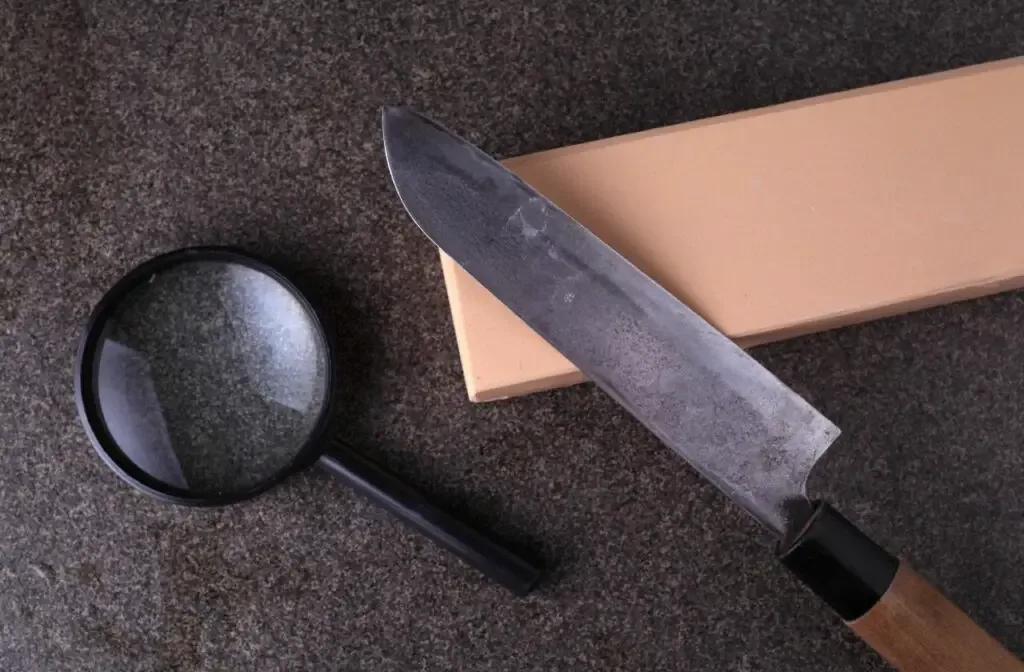
Another frequent question from beginners about knife sharpening is the amount of pressure that should be applied to the knife while sharpening.
Many beginners to sharpening make the mistake of applying too much pressure on the knife. The pressure that must be applied should be light pressure from your fingers on the blade. Let the abrasives on the sharpener do the work rather than trying to use muscle.
Putting too much pressure on the blade can chip and gauge the edge or take too much material off the edge, resulting in the knife becoming dull rather than sharpening the edge.
Frequently Asked Questions About Knife Sharpening
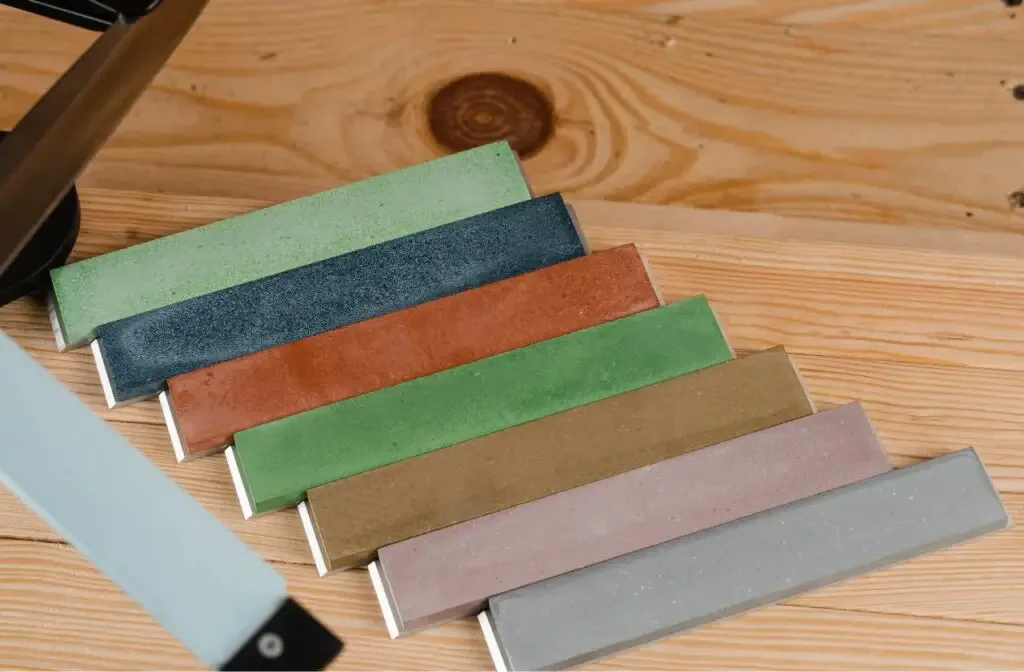
Navigating through the intricacies of knife sharpening can be a daunting task, especially with the myriad of methods and tools available. In this FAQ section, we address some common questions and debunk myths about knife sharpening, aiming to simplify the process for both beginners and seasoned sharpeners alike.
Q: How often should I sharpen my knives?
A: The frequency of knife sharpening depends on usage. Regular users may need to sharpen every few weeks, while occasional users might sharpen a few times a year. Always ensure your knife efficiently cuts through produce without excessive force.
Q: Can I use any stone for knife sharpening?
A: While various stones can sharpen knives, it’s crucial to choose a stone that aligns with your knife type and desired sharpness level. Different materials, like ceramic, diamond, and natural stones, offer distinct sharpening qualities and are suitable for different sharpening stages.
Q: Is it necessary to wet the whetstone before sharpening?
A: Yes, soaking a whetstone (except for diamond and some ceramic stones) is generally recommended. Wetting the stone helps prevent overheating of the blade and ensures smooth gliding of the knife over the stone.
Q: Can a dull knife be restored with sharpening?
A: Absolutely! Dull knives can often be restored to their former glory with proper sharpening techniques and tools. Utilizing a coarse stone to reprofile the edge and progressively moving to finer grits can effectively revive a dull knife.
Q: Is sharpening a knife with a honing rod the same?
A: No, honing and sharpening are distinct processes. Honing aligns the microscopic teeth along the blade edge without removing material, maintaining the sharpness between sharpenings. Sharpening removes metal to create a new edge and is performed less frequently than honing.
Q: Can I sharpen serrated knives on a whetstone?
A: Serrated knives require a different sharpening approach, using a tapered sharpening rod to individually sharpen each serration. Whetstones are generally not recommended for serrated blades due to their flat surface.
Q: Does sharpening wear down the knife?
A: While sharpening does remove a minimal amount of material from the blade, proper technique and using the appropriate sharpening stone will minimize wear, ensuring the longevity of the knife.
Q: Can I sharpen my knives with household items?
A: While household items like a ceramic mug or car window can provide a temporary sharpening solution in a pinch, utilizing designated sharpening tools will ensure optimal, consistent results and prolong the life of your knives.
Q: What is the proper angle for sharpening knives?
A: The optimal sharpening angle varies between knife types and uses. Generally, a 20-degree angle per side is standard for kitchen knives. However, more robust knives, like hunting knives, might use a 25-degree angle, while razor-sharp fillet knives might be closer to 15 degrees. Always refer to the knife manufacturer’s guidelines for specific recommendations.
Q: How do I maintain consistency in the sharpening angle?
A: Maintaining a consistent angle during sharpening can be achieved through practice, muscle memory, and utilizing angle guides if available. Some sharpening tools come with adjustable angle guides to ensure consistency. Alternatively, practicing with a guide until you get a feel for the angle can also be effective. Consistency is key to achieving a sharp, durable edge.
Conclusion
Pulling the edge of a knife across a whetstone is recommended as the best method to get great results when sharpening a knife.
Some people use the push method and prefer to sharpen their knives this way, but experience has shown that the edge produced in this way is not as keen as with the pull method.
When experimenting with sharpening techniques and methods, remember to always try out new things with an old knife that you don’t mind making some mistakes with!
TIP: Sharpening systems are a great option if you are just a beginner in sharpening knives. They help you to sharpen a knife properly. Check out the best sharpening systems in the article below:
Ultimate Guide: Best Knife Sharpening Systems for Beginners
